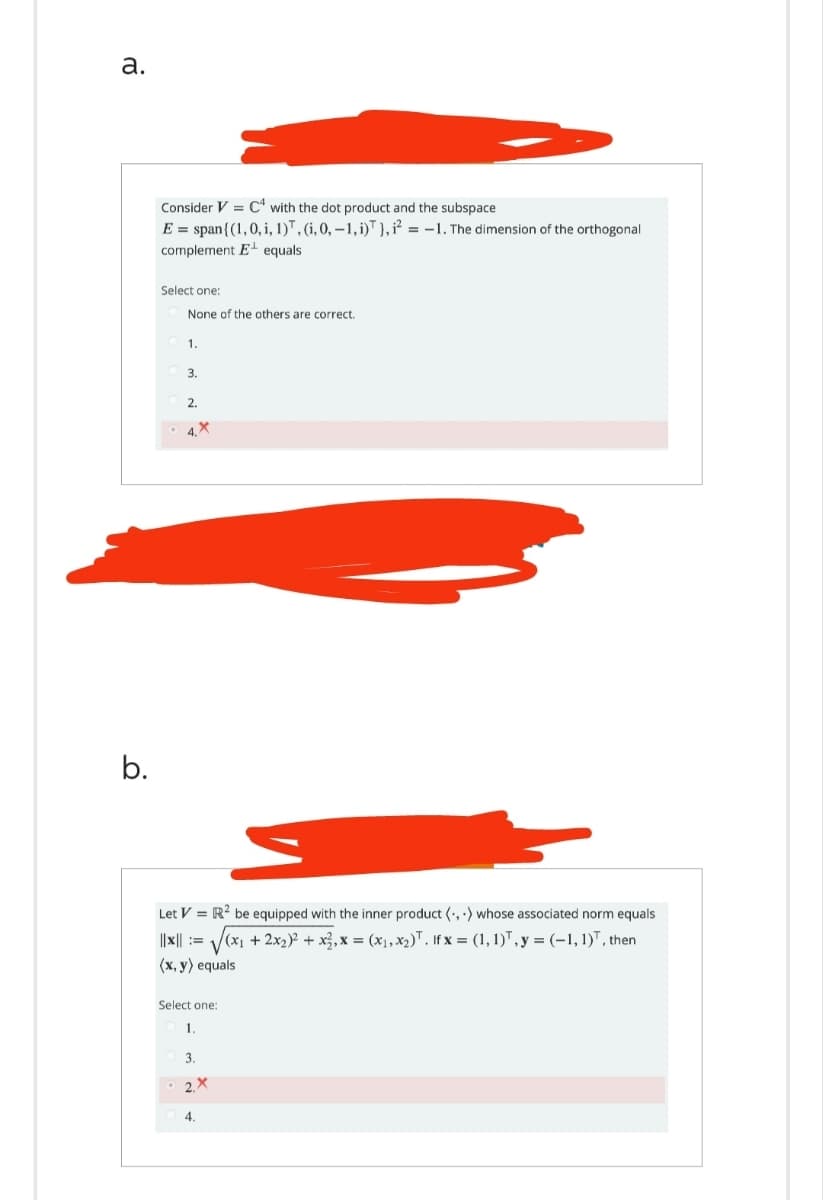a. b. Consider VC with the dot product and the subspace E = span {(1, 0, 1, 1), (i, 0,-1, i)), ² = -1. The dimension of the orthogonal complement E¹ equals Select one: None of the others are correct. 1. 3. 2. 4X Let V = R² be equipped with the inner product (,) whose associated norm equals ||x|| := √(x₁ (x₁ + 2x₂)² + x², x = (x₁, x₂). If x = (1, 1), y = (-1, 1), then (x, y) equals Select one: 1. 3. 2.X 4.
a. b. Consider VC with the dot product and the subspace E = span {(1, 0, 1, 1), (i, 0,-1, i)), ² = -1. The dimension of the orthogonal complement E¹ equals Select one: None of the others are correct. 1. 3. 2. 4X Let V = R² be equipped with the inner product (,) whose associated norm equals ||x|| := √(x₁ (x₁ + 2x₂)² + x², x = (x₁, x₂). If x = (1, 1), y = (-1, 1), then (x, y) equals Select one: 1. 3. 2.X 4.
Elementary Linear Algebra (MindTap Course List)
8th Edition
ISBN:9781305658004
Author:Ron Larson
Publisher:Ron Larson
Chapter4: Vector Spaces
Section4.3: Subspaces Of Vector Spaces
Problem 45E: Consider the vector spaces P0,P1,P2,...,Pn where Pk is the set of all polynomials of degree less...
Related questions
Question
Do both parts otherwise not

Transcribed Image Text:a.
b.
Consider VC with the dot product and the subspace
E = span {(1, 0, 1, 1), (i, 0,-1, i)},i² = -1. The dimension of the orthogonal
complement E¹ equals
Select one:
None of the others are correct.
1.
3.
2.
4X
Let V = R² be equipped with the inner product (,) whose associated norm equals
||x|| = √(x₁
√(x₁ + 2x₂)² + x², x = (x₁, x₂). If x = (1, 1), y = (-1, 1), then
(x, y) equals
Select one:
1.
3.
2.X
4.
Expert Solution
This question has been solved!
Explore an expertly crafted, step-by-step solution for a thorough understanding of key concepts.
Step by step
Solved in 3 steps with 3 images

Recommended textbooks for you

Elementary Linear Algebra (MindTap Course List)
Algebra
ISBN:
9781305658004
Author:
Ron Larson
Publisher:
Cengage Learning

Linear Algebra: A Modern Introduction
Algebra
ISBN:
9781285463247
Author:
David Poole
Publisher:
Cengage Learning

Elementary Linear Algebra (MindTap Course List)
Algebra
ISBN:
9781305658004
Author:
Ron Larson
Publisher:
Cengage Learning

Linear Algebra: A Modern Introduction
Algebra
ISBN:
9781285463247
Author:
David Poole
Publisher:
Cengage Learning